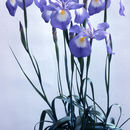pt-BR
nomes no trilho de navegação


Die Rundzungen-Schwertlilie (Iris cycloglossa) ist eine Pflanzenart aus der Gattung der Schwertlilien (Iris) innerhalb der Familie der Schwertliliengewächse (Iridaceae).
Die Rundzungen-Schwertlilie ist eine ausdauernde krautige Pflanze, die Wuchshöhen von meist etwa 40 (20 bis 50) Zentimeter erreicht. Dieser Geophyt bildet Knollen, die oft unzutreffend „Zwiebeln“ genannt werden, als Überdauerungsorgane. Die Wurzeln sind dünn.
Die Blüten sind blauviolett und haben einen Durchmesser von 8 bis 10 Zentimeter. Die Domblätter messen ungefähr 4 × 1,3 Zentimeter. Sie sind verkehrteilanzettlich und zuerst aufrecht, später waagerecht. Die Hängeblätter sind ungefähr 7 Zentimeter lang. Ihr Platte hat einen Durchmesser von 3,5 bis 4 Zentimeter, keinen Kamm und ist rund. Sie ist ungefähr doppelt so breit wie der mehr oder weniger elliptische und geflügelte Nagel. Die Perigonröhre ist 3,5 bis 4,5 Zentimeter lang.
Die Blütezeit liegt im Mai.
Die Chromosomenzahl beträgt 2n = 28.[1]
Die Rundzungen-Schwertlilie kommt Südwest-Afghanistan auf feuchten, im Sommer austrocknenden Standorten am Grund von Tälchen in Höhenlagen von 1450 bis 1700 Meter vor.
Die Rundzungen-Schwertlilie wird selten als Zierpflanze in Rabatten und Steingärten genutzt.
Die Rundzungen-Schwertlilie (Iris cycloglossa) ist eine Pflanzenart aus der Gattung der Schwertlilien (Iris) innerhalb der Familie der Schwertliliengewächse (Iridaceae).
Iris cycloglossa (sometimes known as the Afghani iris) is a species in the genus Iris, in the subgenus Scorpiris. It comes from Afghanistan.
It has a small ovate blackish brown bulb,[2] which also has tuberous roots, which are fragile.[3]
It has between 1-3 flowers per stem, that open in succession from the top down in May and June.[4] They are large, (8–10 cm diam)[4] fragrant, (with a clove-like scent),[5] lavender blue flowers that have a white patch on the falls, it also has a yellow raised ridge.[2] It also unlike other species, it has (4 cm long) upright standards.[5] They have a similar look to Dutch Iris flowers.[3]
The stem is between 20–30 cm tall.[6] It has also generally 6 shiny, grey-green leaves (that have a thin white margin) that are 1.5 cm wide and grow up to 30 cm long at flowering time.[2] They grow along the stem of the plant.[4]
It has 5–6 cm long brown seeds that do not have an aril.[2]
It is sometimes known as the 'Afghani iris' in the US.[7][4]
The name 'cycloglossa' comes from the Greek words, 'tongues arranged in a circle'.[8]
It was first published in Biologiske Skrifter 10(3): 187 by (Norwegian botanist) Per Erland Berg Wendelbo in 1959.[9] It was first illustrated in 'Flora Iranica' in 1975 by Rechinger.[10]
Iris cycloglossa is an accepted name by the RHS.[11]
It prefers to grow in full sun.[4]
It is hardy to USDA Zone 5.[4]
Irises can generally be propagated by division,[12] or by seed growing.
Like many other irises, most parts of the plant are poisonous (rhizome and leaves), if mistakenly ingested can cause stomach pains and vomiting. Also handling the plant may cause a skin irritation or an allergic reaction.[13]
It is only found in a small region near Herat in Afghanistan,[2] at 1450-1700 above sea level.[2] Compared to other species within the genus, it comes from areas subject to winter-spring floods so the bulb tolerates a lot of water and generally moister growing conditions than many other in the Scorpiris genus.[3]
Iris cycloglossa (sometimes known as the Afghani iris) is a species in the genus Iris, in the subgenus Scorpiris. It comes from Afghanistan.
Iris cycloglossa là một loài thực vật có hoa trong họ Diên vĩ. Loài này được Wendelbo miêu tả khoa học đầu tiên năm 1959.[1]
Iris cycloglossa là một loài thực vật có hoa trong họ Diên vĩ. Loài này được Wendelbo miêu tả khoa học đầu tiên năm 1959.